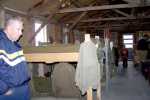Last stop before combat

For many, it was the last stop before combat.
Once a thriving mini-city, sprawled across 2,100 acres containing three runways and more than 200 buildings, the McCook Army Air Base was home to thousands of soldiers from 1943-45. Here, bomber pilots and crews took advantage of the wide open spaces and practiced their maneuvers for the last time on B-17s, B-24s and B-29s before being sent overseas to the Pacific and European wars.
Now, all that remains are the massive hangars, one reconstructed barracks and the Norden bombsight vault, the only structure registered as a historic site. With other World War II airbases slowly disintegrating into the Nebraska landscape, supporters of the McCook site are determined save this one.
A small group braved the biting winds last Saturday at the recently constructed Veteran Memorial Garden, made of concrete paths in the shape of the original runways. There, they paid tribute to veterans of all wars, with a flag placed on each of the eight bronze plaques that recognized the bomber groups that trained here during the war.
"This is living history," said Gloria Cotton of the McCook Air Base Historical Society. "Our goal is to preserve as much as we can."
The Society has in their possession three of the five hangars, which they would like to use as display areas once the roofs are fixed.
The fact that all five hangars are still standing is unusual, said Scott Huchstein of Hartington, an avid World War II air base buff.
"Most lost their hangars because of fire or wind," said Huchstein, who is in the process of writing a book about the 11 air bases constructed in Nebraska. The airbases in Kearney, Grand Island, Ainsworth and Alliance were turned into municipal airports, with the hangars in Fairmont now being used for grain storage. Other bases are being used as feedlots. Army bases were constructed in Lincoln, Omaha, Harvard, Scottsbluff, Scribner and Bruning.
McCook's is unique, he said, with its emphasis on restoring original buildings.
A building salvaged from the base has been retooled as a sleeping barracks, now looking much as it probably did during the war: packed with government-made bunk beds, the room is narrow, poorly lit and crammed with authentic soldier gear.
The other enduring structure, the Norden Bombsight Vault, remains virtually the same, minus the 24-hour guard. The modest concrete building, still with the original barbed wire fencing, housed top-secret equipment that enabled pilots to target their bombs.
The apparatus was considered so confidential that it was placed in the nose of the bomber aircraft only minutes before take-off, Huchstein said.
Hugo Lorenza of Arizona leaned his tall frame over the bunk beds in the refurbished barracks and watched as visitors trailed in, one of which was Sen. Ben Nelson who spoke at the flag ceremony. He commented on what the base meant for him.
"I don't want anything to happen to this," said the World War II veteran, who lived at the air base for three months as an electrician for B-29s.
"This is a piece of World War II we can see and touch. Look at World War I. We did nothing to preserve much from that war. This is something we can do for the next generation."
